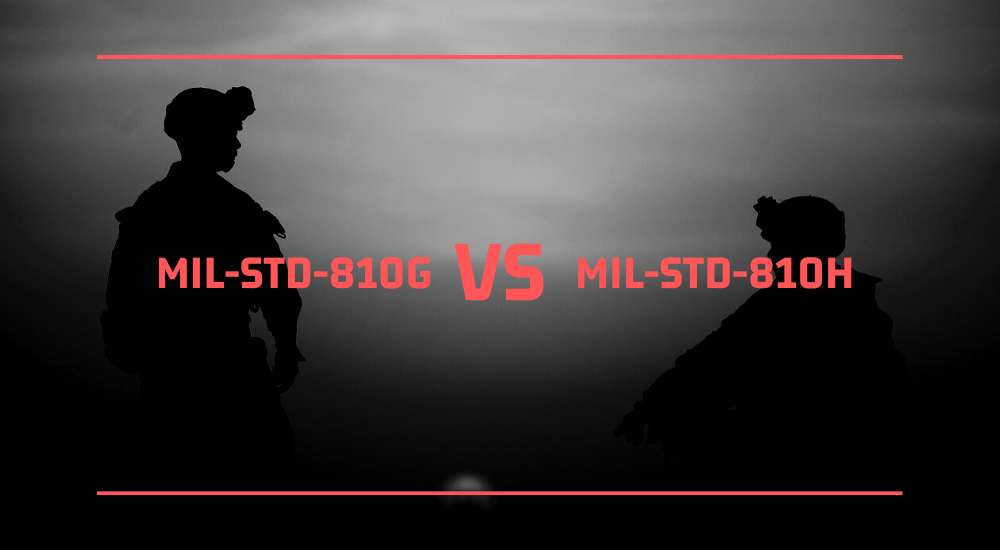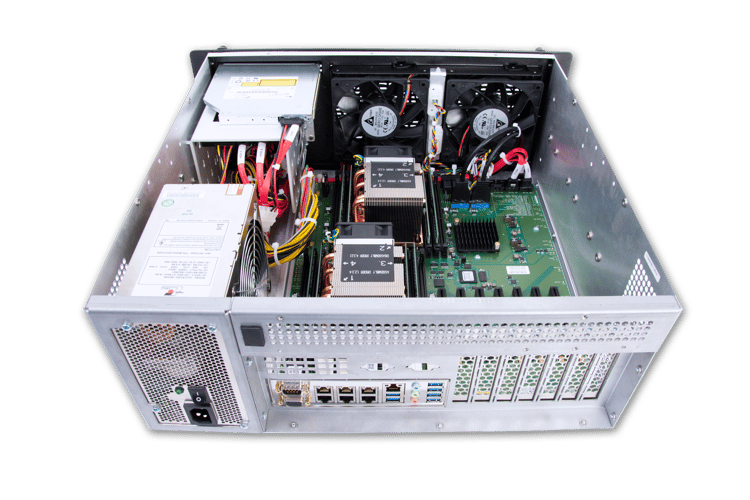Share this
What's the difference between MIL-STD-810G and MIL-STD-810H? [PDFs]
by Brett Daniel on May 4, 2020 4:27:26 PM

Graphic: The publication of MIL-STD-810H came with many changes to the previous iteration, MIL-STD-810G. We'll discuss and list them out in this blog post.
Table of Contents
- What is MIL-STD?
- What is MIL-STD-810?
- What tests are included in MIL-STD-810G testing?
- What changes are included in MIL-STD-810H?
- Trenton Systems: A One-Stop Shop for MIL-STD-810 Servers & Workstations
Note: Trenton Systems is not a compliance testing facility. We manufacture rugged servers and workstations that conform to military and industrial standards, such as MIL-STD-810 and DO-160, and we can ensure that our systems comply with these standards using our in-house testing equipment, or by sending our systems to a third-party compliance testing laboratory for validation, but our facility does not offer compliance testing services for products manufactured outside of Trenton Systems. For a list of laboratories that can assist you with your testing needs, please read this blog post, which lists the best compliance testing laboratories in the world.
Learn all about the different MIL-STD-810 test methods in our ongoing MIL-STD-810H series. Read the first installment here. Check out our MIL-STD-810 servers blog post to learn more about rugged computers and how they're enhancing military defense. You can also read our comprehensive MIL-STD-810 overview.
Introduction
The United States Department of Defense officially released MIL-STD-810H, the successor to MIL-STD-810G, in January of 2019.
 With this revision comes numerous changes, both minor and major, to MIL-STD-810’s laboratory test methods.
With this revision comes numerous changes, both minor and major, to MIL-STD-810’s laboratory test methods.
In this blog post, we’ll review MIL-STD, MIL-STD-810G, and include an outline of the changes made in MIL-STD-810H. Stick around for a comprehensive overview.
What is MIL-STD?
MIL-STD is just an acronym for military standard.
In the United States, military standards, or defense standards, are enforced by the U.S. Department of Defense and maintained by the Air Force, Army, and Navy.
If a product is MIL-STD-certified or MIL-STD-compliant, that product is compliant with certain requirements and standardization objectives set forth by the DoD.
According to the DoD, the purpose of military standards is to ensure the interoperability and commonality of products and equipment used in military applications.
“Standardization documents are developed and used for products, materials, and processes that have multiple applications to promote commonality and interoperability among the Military Departments and the Defense Agencies and between the United States and its allies, and to limit the variety of items in the military supply system,” the Department’s website states.
In a nutshell, by establishing equipment consistency and compatibility, these standards safeguard against equipment incongruity, inefficiency, ineffectiveness, and worst-case scenario, failure in the field.
MIL-STD-certified products are usually designed to survive in extreme environmental conditions. This process is known as usually referred to as environmental stress testing, compliance testing, or ruggedization, which means to “strengthen for better resistance to wear, stress, and abuse,” according to Merriam-Webster.
Military standards are a vital part of product development for companies that sell equipment to the military, which needs to ensure that such equipment can sustain and continue operating properly in the face of extreme environments that could cause damage or malfunction.
MIL-STD is also sometimes referred to as a MIL-SPEC, which stands for military specification. When shopping for or reading about MIL-STD-certified computers, you’ll often see them referred to as a MIL-SPEC server, a MIL-SPEC workstation, or just "MIL-SPEC computer." This just means that they meet some sort of military specification, such as MIL-STD-810.
What is MIL-STD-810?
MIL-STD-810, officially entitled "Environmental Engineering Considerations and Laboratory Tests," is a military standard that outlines the testing and design requirements of equipment used by the military to verify the equipment's ability to sustain environmental stress incidents throughout its life cycle.
Some of the test methods and procedures that a MIL-STD-810-certified product may undergo include but are not limited to mechanical shock, vibration, temperature, low pressure (altitude), humidity, fungus, salt fog, and explosive atmosphere.
Testing and certifying equipment to these and other harsh conditions lets military contractors know that the products they’re purchasing are durable, reliable, sustainable, and fit for a solution that's being sold to the DoD for use in extreme environments.
Photo: Another test that a MIL-STD-810-certified rugged computer might undergo is the rain test, which assesses reliability in environments that receive a lot of rainfall, such as the Amazon Rainforest. It also tests for water spray or dripping during storage, transport and operation.
What tests are included in MIL-STD-810G testing?
MIL-STD-810G is the precursory revision to MIL-STD-810H, the latest revision published in 2019.
The DoD published MIL-STD-810G in 2008 and revised it in 2014.
MIL-STD-810G is divided into three parts:
- Environmental Engineering Program Guidelines
- Laboratory Test Methods
- World Climatic Regions – Guidance
Test methods are what interest most contractors. A MIL-STD-810G-certified server may undergo a combination of assessments for resistance to gunfire shock, pyroshock, acoustic noise, immersion, contamination by fluids - any of the methods listed in document. Each of these methods include one or more testing procedures that allow test engineers tailor an assessment to a product's end environment.
For example, MIL-STD-810 immersion testing measures equipment's performance and durability while partially or totally immersed in water; therefore, the Navy might be interested in ensuring that a product they're purchasing is certified to this standard.
Check out our comprehensive blog post "MIL-STD-810 Overview: Everything You Need To Know" for a deeper dive into what makes a product MIL-STD-810G-compliant.

Photo: MIL-STD-810H includes changes to Acceleration, High Temperature, Low Temperature, Vibration, and more.
What changes are included in MIL-STD-810H?
MIL-STD-810H, the latest revision of MIL-STD-810, includes numerous changes from its predecessor, MIL-STD-810G.
As you'll see, the standard underwent a multitude of changes and updates for its “H” iteration.
When reviewing the 1,089-page MIL-STD-810H, here’s what you can do to make your search for specific changes easier:
- Click on the hyperlinks under "Part Two – Laboratory Test Methods," which begins on Page 7. These links will take you directly to your test method of interest.
- Note the thin, black lines in the left-hand margins of the document. These signify changes from the previous revision, MIL-STD-810G.
It's important to note that mechanical shock, one of the most widely used testing methods, underwent extensive changes for MIL-STD-810H and therefore does not include line revision indicators.
So, without further ado, changes to MIL-STD-810-H include but are not limited to:
- The definition of temperature shock
- The Test and Evaluation Master Plan (TEMP)
- Test conditions and tolerances for test conditions
- Calibration interval guidelines
- Temperature change rate
- MIL-STD-810H 500.6 – Acceleration – Test Pressures (Altitude) and Temperature
- MIL-STD-810H 501.7 – High Temperature – Procedure I – Storage and Procedure II – Operation
- MIL-STD-810H 502.7 – Low Temperature – Procedure I – Storage
- MIL-STD-810H 503.7 – Temperature Shock – including changes to the following sections: Selecting Procedure Variations, Determine Test Levels and Conditions, Test Duration (number of shocks), Interruption Due to Chamber Malfunction, Pretest Standard Ambient Checkout, Procedure I – Shock from Constant Extreme Temperatures, Procedure I-B – Single Cycle Shock from Constant Extreme Temperature and Procedure I-C – Multi-Cycle Shocks from Constant Extreme Temperature
- MIL-STD-810H 504.3 – Contamination by Fluids – Pretest Standard Ambient Checkout and Procedure
- MIL-STD-810H 505.7 – Solar Radiation (Sunshine) – including changes to the following sections: Limitations, Spectral Power Distribution, Post-Test, Test Facility, Solar Radiation Source and Test Parameter Tolerances
- MIL-STD-810H 506.6 – Rain – including changes to the following sections: Droplet Size, Water Pressure, Pretest, Post-Test, Procedure I – Rain and Blowing Rain, Procedure II – Exaggerated, Procedure III – Drip, Interruption Due to Test Item Operation Failure and Pretest Standard Ambient Checkout
- MIL-STD-810H 508.8 – Fungus – including changes to the following sections: Purpose, Application, Limitations, Physical Interference, Choice of Fungus, Pretest, Table 508.8-I – Test Fungus, Post-Test, Test Chamber, Air Velocity, Preparation of Mixed Spore Suspension and Incubation of the Test Item
- MIL-STD-810H 509.7 – Salt Fog – Fallout Rate, Salt Fog Collection Receptacles and Referenced Documents
- MIL-STD-810H 510.7 – Sand and Dust – including changes to the following sections: Purpose, Limitations, Effects of Sand and Dust Environments, Sequence Among Other Methods, Selecting Procedures, Pretest, During Test, Post-Test, Temperature, Air Velocity and Dust Composition
- MIL-STD-810H 511.7 – Explosive Atmosphere – Fuel, Post-Test and Test Facility
- MIL-STD-810H 512.6 – Immersion – Pretest and Procedure I – Immersion
- MIL-STD-810H 513.8 – Acceleration – including changes to the following sections: Acceleration versus Shock, Climatic Conditioning, Selecting a Procedure, Procedure Selection Considerations, Strength Test, Test Axes and Table 513.8-I. Suggested g levels for Procedure I - Structural Test
- MIL-STD-810H 514.8 – Vibration – including changes to the following sections: Application, Limitations, Pretest, Acceleration Input Control Strategy, Table 514.8-II. Random Vibration Test Tolerances, Sinusoidal Vibration Test Tolerances and Procedure III - Large Assembly Transport
- MIL-STD-810H 515.8 – Acoustic Noise – Calibration and Tolerance and Table 515.8A-I. Overall Sound Pressure Levels and Durations
- MIL-STD-810H 518.2 – Acidic Atmosphere – Chemical Composition and Concentration
- MIL-STD-810H 522.2 – Ballistic Shock – Controls / Tolerance
- MIL-STD-810H 523.4 – Vibro-Acoustic / Temperature – Temperature, Shock, Sequence Among Other Methods, Pretest, Controls / Tolerances
- MIL-STD-810H 524.1 – Freeze / Thaw – Controls
- MIL-STD-810H 525.2 – Time Waveform Replication – General Considerations and Terminology, Figure 525.2-1. Basic TWR Test Modes as Related to Time Trace Scaling, General TWR Test Philosophy with Regard to Time Trace Simulation (and Scaling), Figure 525.2-2. Basic TWR Test Simulation Combinations, Limitations, Effects of Transition to Time Trace TWR, Sequence Among Other Methods and Tolerances
- MIL-STD-810H 526.2 – Rail Impact – including changes to the following sections: Purpose, Application, Limitations, Tailoring Guidance, Design and Modeling Guidance, Pretest, During Test, Buffer Railcars, Test Railcar, Locomotive, Track, Controls, Test Interruption, Test Setup, Rail Impact Procedure, Additional Requirements and Analysis of Results
Photo: An inside look at a Trenton Systems 4U Rugged Server, certified to MIL-STD-810 standards. A server certified to this standard is usually just referred to as a MIL-STD-810 server for short.
Trenton Systems: A One-Stop Shop for MIL-STD-810 Servers & Workstations
We at Trenton Systems hope this blog post will be a helpful resource to you as you review and familiarize yourself with the changes in MIL-STD-810H.
Trenton Systems’ rugged servers, workstations, and blade servers can be MIL-STD-810-certified to the following standards in-house: mechanical shock, vibration, temperature, and humidity. This includes our:
- 5U Rugged Servers
- 4U Rugged Servers
- 3U Rugged Servers
- 2U Rugged Servers
- 1U Rugged Servers
- 5U Rugged Workstations
- 4U Rugged Workstations
- 2U Rugged Workstations
- 1URugged Workstations
- 2U Rugged Blade Servers
- 1U Rugged Blade Servers
Contact us today to find out more about how we at Trenton Systems certify our made-in-USA rugged servers and workstations to military and industrial standards.
And for more information about MIL-STD-810 or to download previous revisions, visit the Institute of Environmental Sciences and Technology’s MIL-STD-810 Document Page.
Share this
- High-performance computers (42)
- Military computers (38)
- Rugged computers (32)
- Cybersecurity (25)
- Industrial computers (25)
- Military servers (24)
- MIL-SPEC (20)
- Rugged servers (19)
- Press Release (17)
- Industrial servers (16)
- MIL-STD-810 (16)
- 5G Technology (14)
- Intel (13)
- Rack mount servers (12)
- processing (12)
- Computer hardware (11)
- Edge computing (11)
- Rugged workstations (11)
- Made in USA (10)
- Partnerships (9)
- Rugged computing (9)
- Sales, Marketing, and Business Development (9)
- Trenton Systems (9)
- networking (9)
- Peripheral Component Interconnect Express (PCIe) (7)
- Encryption (6)
- Federal Information Processing Standards (FIPS) (6)
- GPUs (6)
- IPU (6)
- Joint All-Domain Command and Control (JADC2) (6)
- Server motherboards (6)
- artificial intelligence (6)
- Computer stress tests (5)
- Cross domain solutions (5)
- Mission-critical servers (5)
- Rugged mini PCs (5)
- AI (4)
- BIOS (4)
- CPU (4)
- Defense (4)
- Military primes (4)
- Mission-critical systems (4)
- Platform Firmware Resilience (PFR) (4)
- Rugged blade servers (4)
- containerization (4)
- data protection (4)
- virtualization (4)
- Counterfeit electronic parts (3)
- DO-160 (3)
- Edge servers (3)
- Firmware (3)
- HPC (3)
- Just a Bunch of Disks (JBOD) (3)
- Leadership (3)
- Navy (3)
- O-RAN (3)
- RAID (3)
- RAM (3)
- Revision control (3)
- Ruggedization (3)
- SATCOM (3)
- Storage servers (3)
- Supply chain (3)
- Tactical Advanced Computer (TAC) (3)
- Wide-temp computers (3)
- computers made in the USA (3)
- data transfer (3)
- deep learning (3)
- embedded computers (3)
- embedded systems (3)
- firmware security (3)
- machine learning (3)
- Automatic test equipment (ATE) (2)
- C6ISR (2)
- COTS (2)
- COVID-19 (2)
- CPUs (2)
- Compliance (2)
- Compute Express Link (CXL) (2)
- Computer networking (2)
- Controlled Unclassified Information (CUI) (2)
- DDR (2)
- DDR4 (2)
- DPU (2)
- Dual CPU motherboards (2)
- EW (2)
- I/O (2)
- Military standards (2)
- NVIDIA (2)
- NVMe SSDs (2)
- PCIe (2)
- PCIe 4.0 (2)
- PCIe 5.0 (2)
- RAN (2)
- SIGINT (2)
- SWaP-C (2)
- Software Guard Extensions (SGX) (2)
- Submarines (2)
- Supply chain security (2)
- TAA compliance (2)
- airborne (2)
- as9100d (2)
- chassis (2)
- data diode (2)
- end-to-end solution (2)
- hardware security (2)
- hardware virtualization (2)
- integrated combat system (2)
- manufacturing reps (2)
- memory (2)
- mission computers (2)
- private 5G (2)
- protection (2)
- secure by design (2)
- small form factor (2)
- software security (2)
- vRAN (2)
- zero trust (2)
- zero trust architecture (2)
- 3U BAM Server (1)
- 4G (1)
- 4U (1)
- 5G Frequencies (1)
- 5G Frequency Bands (1)
- AI/ML/DL (1)
- Access CDS (1)
- Aegis Combat System (1)
- Armed Forces (1)
- Asymmetric encryption (1)
- C-RAN (1)
- COMINT (1)
- Cloud-based CDS (1)
- Coast Guard (1)
- Compliance testing (1)
- Computer life cycle (1)
- Containers (1)
- D-RAN (1)
- DART (1)
- DDR5 (1)
- DMEA (1)
- Data Center Modular Hardware System (DC-MHS) (1)
- Data Plane Development Kit (DPDK) (1)
- Defense Advanced Research Projects (DARP) (1)
- ELINT (1)
- EMI (1)
- EO/IR (1)
- Electromagnetic Interference (1)
- Electronic Warfare (EW) (1)
- FIPS 140-2 (1)
- FIPS 140-3 (1)
- Field Programmable Gate Array (FPGA) (1)
- Ground Control Stations (GCS) (1)
- Hardware-based CDS (1)
- Hybrid CDS (1)
- IES.5G (1)
- ION Mini PC (1)
- IP Ratings (1)
- IPMI (1)
- Industrial Internet of Things (IIoT) (1)
- Industry news (1)
- Integrated Base Defense (IBD) (1)
- LAN ports (1)
- LTE (1)
- Life cycle management (1)
- Lockheed Martin (1)
- MIL-S-901 (1)
- MIL-STD-167-1 (1)
- MIL-STD-461 (1)
- MIL-STD-464 (1)
- MOSA (1)
- Multi-Access Edge Computing (1)
- NASA (1)
- NIC (1)
- NIC Card (1)
- NVMe (1)
- O-RAN compliant (1)
- Oil and Gas (1)
- Open Compute Project (OCP) (1)
- OpenRAN (1)
- P4 (1)
- PCIe card (1)
- PCIe lane (1)
- PCIe slot (1)
- Precision timestamping (1)
- Product life cycle (1)
- ROM (1)
- Raytheon (1)
- Remotely piloted aircraft (RPA) (1)
- Rugged computing glossary (1)
- SEDs (1)
- SIM Card (1)
- Secure boot (1)
- Sensor Open Systems Architecture (SOSA) (1)
- Small form-factor pluggable (SFP) (1)
- Smart Edge (1)
- Smart NIC (1)
- SmartNIC (1)
- Software-based CDS (1)
- Symmetric encryption (1)
- System hardening (1)
- System hardening best practices (1)
- TME (1)
- Tech Partners (1)
- Total Memory Encryption (TME) (1)
- Transfer CDS (1)
- USB ports (1)
- VMEbus International Trade Association (VITA) (1)
- Vertical Lift Consortium (VLC) (1)
- Virtual machines (1)
- What are embedded systems? (1)
- Wired access backhaul (1)
- Wireless access backhaul (1)
- accredidation (1)
- aerospace (1)
- air gaps (1)
- airborne computers (1)
- asteroid (1)
- authentication (1)
- autonomous (1)
- certification (1)
- cognitive software-defined radios (CDRS) (1)
- command and control (C2) (1)
- communications (1)
- cores (1)
- custom (1)
- customer service (1)
- customer support (1)
- data linking (1)
- data recording (1)
- ethernet (1)
- full disk encryption (1)
- hardware monitoring (1)
- heat sink (1)
- hypervisor (1)
- in-house technical support (1)
- input (1)
- integrated edge solution (1)
- international business (1)
- licensed spectrum (1)
- liquid cooling (1)
- mCOTS (1)
- microelectronics (1)
- missile defense (1)
- mixed criticality (1)
- moving (1)
- multi-factor authentication (1)
- network slicing (1)
- neural networks (1)
- new headquarters (1)
- next generation interceptor (1)
- non-volatile memory (1)
- operating system (1)
- output (1)
- outsourced technical support (1)
- post-boot (1)
- pre-boot (1)
- private networks (1)
- public networks (1)
- radio access network (RAN) (1)
- reconnaissance (1)
- rugged memory (1)
- secure flash (1)
- security (1)
- self-encrypting drives (SEDs) (1)
- sff (1)
- software (1)
- software-defined radios (SDRs) (1)
- speeds and feeds (1)
- standalone (1)
- storage (1)
- systems (1)
- tactical wide area networks (1)
- technical support (1)
- technology (1)
- third-party motherboards (1)
- troposcatter communication (1)
- unlicensed spectrum (1)
- volatile memory (1)
- vpx (1)
- zero trust network (1)
- January 2025 (1)
- November 2024 (1)
- October 2024 (1)
- August 2024 (1)
- July 2024 (1)
- May 2024 (1)
- April 2024 (3)
- February 2024 (1)
- November 2023 (1)
- October 2023 (1)
- July 2023 (1)
- June 2023 (3)
- May 2023 (7)
- April 2023 (5)
- March 2023 (7)
- December 2022 (2)
- November 2022 (6)
- October 2022 (7)
- September 2022 (8)
- August 2022 (3)
- July 2022 (4)
- June 2022 (13)
- May 2022 (10)
- April 2022 (4)
- March 2022 (11)
- February 2022 (4)
- January 2022 (4)
- December 2021 (1)
- November 2021 (4)
- September 2021 (2)
- August 2021 (1)
- July 2021 (2)
- June 2021 (3)
- May 2021 (4)
- April 2021 (3)
- March 2021 (3)
- February 2021 (8)
- January 2021 (4)
- December 2020 (5)
- November 2020 (5)
- October 2020 (4)
- September 2020 (4)
- August 2020 (6)
- July 2020 (9)
- June 2020 (11)
- May 2020 (13)
- April 2020 (8)
- February 2020 (1)
- January 2020 (1)
- October 2019 (1)
- August 2019 (2)
- July 2019 (2)
- March 2019 (1)
- January 2019 (2)
- December 2018 (1)
- November 2018 (2)
- October 2018 (5)
- September 2018 (3)
- July 2018 (1)
- April 2018 (2)
- March 2018 (1)
- February 2018 (9)
- January 2018 (27)
- December 2017 (1)
- November 2017 (2)
- October 2017 (3)
/Trenton%20Systems%20Circular%20Logo-3.png?width=50&height=50&name=Trenton%20Systems%20Circular%20Logo-3.png)


No Comments Yet
Let us know what you think